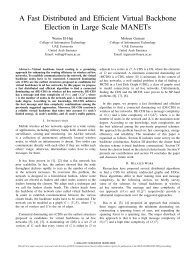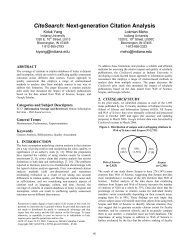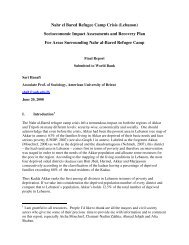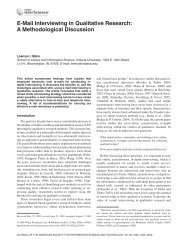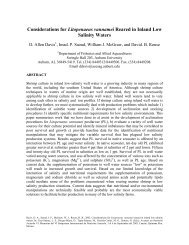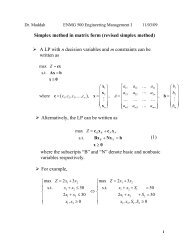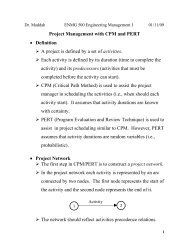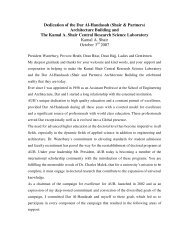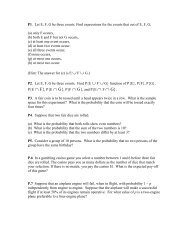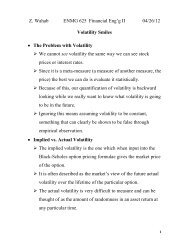The Implications of Product Architecture on the Firm - American ...
The Implications of Product Architecture on the Firm - American ...
The Implications of Product Architecture on the Firm - American ...
You also want an ePaper? Increase the reach of your titles
YUMPU automatically turns print PDFs into web optimized ePapers that Google loves.
THE IMPLICATIONS OF PRODUCT ARCHITECTURE ON THE FIRM 123Table I. Overview <str<strong>on</strong>g>of</str<strong>on</strong>g> Research Questi<strong>on</strong>s Discussed in <strong>the</strong> Paperis worth noting that for some <str<strong>on</strong>g>of</str<strong>on</strong>g> <strong>the</strong>se questi<strong>on</strong>s listedin Table I, a c<strong>on</strong>siderable amount <str<strong>on</strong>g>of</str<strong>on</strong>g> research has alreadytaken place (e.g., impact <str<strong>on</strong>g>of</str<strong>on</strong>g> product architecture<strong>on</strong> product development lead-time and cost), whileo<strong>the</strong>r questi<strong>on</strong>s are less researched (e.g., impact <str<strong>on</strong>g>of</str<strong>on</strong>g>product architecture <strong>on</strong> organizati<strong>on</strong>al design or marketingfuncti<strong>on</strong>s).4. BUSINESS ASSETSThis secti<strong>on</strong> explores <strong>the</strong> influence <str<strong>on</strong>g>of</str<strong>on</strong>g> product architecture<strong>on</strong> three kinds <str<strong>on</strong>g>of</str<strong>on</strong>g> business assets: knowledge portfolio,product portfolio, and brand portfolio. 6 Byknowledge portfolio, we mean all knowledge that resideswithin <strong>the</strong> firm, whe<strong>the</strong>r stored physically orwithin individuals, and <strong>the</strong> learning tools <str<strong>on</strong>g>of</str<strong>on</strong>g> <strong>the</strong> firm thatultimately help <strong>the</strong> firm remain competitive. A firm’sproduct portfolio c<strong>on</strong>sists <str<strong>on</strong>g>of</str<strong>on</strong>g> all products available in<strong>the</strong> marketplace at any given time, and <strong>the</strong> brand portfoliois <strong>the</strong> grouping <str<strong>on</strong>g>of</str<strong>on</strong>g> all brands associated with aproduct by <strong>the</strong> c<strong>on</strong>sumer during <strong>the</strong> purchase decisi<strong>on</strong>.4.1. Knowledge PlanningKnowledge is <strong>the</strong> ability to make good decisi<strong>on</strong>s based<strong>on</strong> an understanding <str<strong>on</strong>g>of</str<strong>on</strong>g> causal relati<strong>on</strong>ships. Learninghappens as informati<strong>on</strong>—structured data—is used toadvance <strong>the</strong> understanding <str<strong>on</strong>g>of</str<strong>on</strong>g> a system [Bohn, 1997].<str<strong>on</strong>g>The</str<strong>on</strong>g>re are two basic kinds <str<strong>on</strong>g>of</str<strong>on</strong>g> learning that developproduct, process, and market knowledge: acquisitiveand experimental [Lei, Hitt, and Bettis, 1996; Zahra,6 Physical assets, such as infrastructure, are not included here, but canbe easily accounted for in <strong>the</strong> processes layer.Mels<strong>on</strong>, and Bogner, 1999]. Acquisitive learning (exogenouslearning according to Lambe and Spekman[1997]) takes place when <strong>the</strong> firm “acquires and internalizesknowledge” from <strong>the</strong> outside, such as <strong>the</strong> casewith technology partnerships [Duysters, Kok, andVaandrager, 1999; Nijssen, Reekum, and Hulsh<str<strong>on</strong>g>of</str<strong>on</strong>g>f,2001] or technology outsourcing [Howells, 1999,Kimzey and Kurokawa, 2002]. Experimental learningoccurs within <strong>the</strong> firm and generates new and distinctiveknowledge for <strong>the</strong> organizati<strong>on</strong>, which <str<strong>on</strong>g>of</str<strong>on</strong>g>ten leads to<strong>the</strong> development <str<strong>on</strong>g>of</str<strong>on</strong>g> core competencies [Prahalad andHamel, 1991]. In order to remain competitive, firmsmust not <strong>on</strong>ly manage <strong>the</strong> development <str<strong>on</strong>g>of</str<strong>on</strong>g> strategicknowledge, but also develop ways to retain and cascadea portfolio <str<strong>on</strong>g>of</str<strong>on</strong>g> knowledge throughout <strong>the</strong> firm.Knowledge has been classified in various ways [Polanyi,1967; Henders<strong>on</strong> and Clark, 1990; N<strong>on</strong>aka,1994; Spender and Grant, 1996]. One classificati<strong>on</strong> <str<strong>on</strong>g>of</str<strong>on</strong>g>special interest to this paper is between comp<strong>on</strong>ent andarchitectural knowledge [Henders<strong>on</strong> and Clark, 1990;Henders<strong>on</strong> and Cockburn, 1994]. Comp<strong>on</strong>ent knowledgecould be explicit or tacit and reside within anindividual or an organizati<strong>on</strong>; but architectural knowledgeis generally tacit and stored within a larger systemor group [Garud and Nayyar, 1994; Matusik and Hill,1998]. 7 Architectural knowledge is created in two ways.<str<strong>on</strong>g>The</str<strong>on</strong>g> first method is through defining <strong>the</strong> interfacesbetween modules as discussed in Secti<strong>on</strong> 2. Sanchez[2000, p. 611] noted that “trying to fully specify <strong>the</strong>7 Explicit knowledge refers to knowledge that can be easily articulated,captured, and transferred. Tacit knowledge is just <strong>the</strong> oppositeand can <strong>on</strong>ly be acquired through experience [N<strong>on</strong>aka, 1994; Polanyi,1967].Systems Engineering DOI 10.1002/sys
THE IMPLICATIONS OF PRODUCT ARCHITECTURE ON THE FIRM 125ety: strategic and tactical. Strategic variety refers to <strong>the</strong>perceivable differences in products from <strong>the</strong> c<strong>on</strong>sumer’sperspective [Martin and Ishii, 1996]. Strategicvariety comes in two forms, variegati<strong>on</strong> and differentiati<strong>on</strong>[Ramdas, 2002]. Variegati<strong>on</strong> refers to <strong>the</strong> varietydisplayed within a single firm’s portfolio, and differentiati<strong>on</strong>refers to <strong>the</strong> variety displayed between a singlefirm’s products and all o<strong>the</strong>r competing products. <str<strong>on</strong>g>The</str<strong>on</strong>g>variegati<strong>on</strong> displayed within <strong>the</strong> portfolio at a particularpoint in time has been called spatial variety and overtime as generati<strong>on</strong>al variety [Martin and Ishii, 2002].Alternatively, tactical variety refers to differences betweenproducts that are not obvious to <strong>the</strong> c<strong>on</strong>sumer[Martin and Ishii, 1996], but are necessary for at least<strong>on</strong>e <str<strong>on</strong>g>of</str<strong>on</strong>g> <strong>the</strong> following reas<strong>on</strong>s [Kota, Sethuraman, andMiller, 2000]: (1) varying comp<strong>on</strong>ent packaging c<strong>on</strong>straintswithin a variant; (2) implementati<strong>on</strong> <str<strong>on</strong>g>of</str<strong>on</strong>g> newtechnology; and (3) <strong>the</strong> “idiosyncrasies” <str<strong>on</strong>g>of</str<strong>on</strong>g> independentdesign teams.A family <str<strong>on</strong>g>of</str<strong>on</strong>g> products is tied toge<strong>the</strong>r by its “core” set<str<strong>on</strong>g>of</str<strong>on</strong>g> shared comp<strong>on</strong>ents, <str<strong>on</strong>g>of</str<strong>on</strong>g>ten referred to as <strong>the</strong> platform.In order to develop <strong>the</strong> product portfolio efficiently,businesses must develop good platforms by carefullyaligning <strong>the</strong> product plan, differentiati<strong>on</strong> plan, and comm<strong>on</strong>alityplan [Roberts<strong>on</strong> and Ulrich, 1998]. <str<strong>on</strong>g>The</str<strong>on</strong>g> productplan describes, at a c<strong>on</strong>ceptual level, what productswill be delivered to market segments identified as importantto developing <strong>the</strong> business. <str<strong>on</strong>g>The</str<strong>on</strong>g> differentiati<strong>on</strong>plan describes how <strong>the</strong> new products will be differentfrom ei<strong>the</strong>r existing or so<strong>on</strong> to be released products.C<strong>on</strong>versely, <strong>the</strong> comm<strong>on</strong>ality plan defines which productelements (subassemblies, subsystems, comp<strong>on</strong>ents,etc.) will be comm<strong>on</strong> across portfolio members. <str<strong>on</strong>g>The</str<strong>on</strong>g>sethree plans are essential to ensure that markets exist fornew products, <strong>the</strong> new products can be designedquickly, and <strong>the</strong>re is sufficient comp<strong>on</strong>ent sharing tohelp create ec<strong>on</strong>omies <str<strong>on</strong>g>of</str<strong>on</strong>g> scale. Businesses use productarchitecture to efficiently and ec<strong>on</strong>omically develop <strong>the</strong>product variants that are believed to help increase <strong>the</strong>value <str<strong>on</strong>g>of</str<strong>on</strong>g> <strong>the</strong>ir portfolio. Families <str<strong>on</strong>g>of</str<strong>on</strong>g> products 8 generallysolve <strong>the</strong> same type <str<strong>on</strong>g>of</str<strong>on</strong>g> problem for <strong>the</strong> c<strong>on</strong>sumer, yeteach product exhibits different attribute performancelevels [Li and Azarm, 2002].New products <str<strong>on</strong>g>of</str<strong>on</strong>g>ten make old products obsolete andmay even cannibalize sales <str<strong>on</strong>g>of</str<strong>on</strong>g> existing products [C<strong>on</strong>ner,1988]. Introducti<strong>on</strong> strategies for low- and highendproducts are yet ano<strong>the</strong>r product planningc<strong>on</strong>siderati<strong>on</strong>. For example, should a low-end productthat fulfills needs similarly to that <str<strong>on</strong>g>of</str<strong>on</strong>g> a high-end productbe introduced before, c<strong>on</strong>currently, or after its high-endcounterpart [Baldwin and Clark, 2002; Moorthy and8 <str<strong>on</strong>g>Product</str<strong>on</strong>g>s coming from a family architecture as discussed earlier inSecti<strong>on</strong> 3.Png, 1992]? Some researchers note that <strong>the</strong> pace <str<strong>on</strong>g>of</str<strong>on</strong>g>product releases and <strong>the</strong> amount <str<strong>on</strong>g>of</str<strong>on</strong>g> variety am<strong>on</strong>g itsproducts are two important dimensi<strong>on</strong>s that influencehow firms plan products [Sanders<strong>on</strong> and Uzumeri,1997; Fisher, Jain, and MacDuffie, 1996]. If <strong>the</strong> firm isin an industry where <strong>the</strong> pace <str<strong>on</strong>g>of</str<strong>on</strong>g> product releases is slowand <strong>on</strong>ly small amounts <str<strong>on</strong>g>of</str<strong>on</strong>g> variety are needed to remaincompetitive, it is probably not advisable for <strong>the</strong> firm topursue a platform strategy as dem<strong>on</strong>strated in Figure 2.When a quick pace for introducing new products isrequired and/or a large amount <str<strong>on</strong>g>of</str<strong>on</strong>g> variety is required tocompete, platforming c<strong>on</strong>cepts begin to make sense.<str<strong>on</strong>g>The</str<strong>on</strong>g> most important aspect <str<strong>on</strong>g>of</str<strong>on</strong>g> a platform philosophy isflexibility—how much and <str<strong>on</strong>g>of</str<strong>on</strong>g>ten can <strong>the</strong> platform adaptbefore it becomes obsolete [G<strong>on</strong>zalez-Zugasti, Otto,and Baker, 2000].Hypo<strong>the</strong>sis #3<str<strong>on</strong>g>Product</str<strong>on</strong>g> architecture (i.e., platform decisi<strong>on</strong>s) directlyaffects <strong>the</strong> firm’s ability to efficiently and effectivelymanage <strong>the</strong> product portfolio.<str<strong>on</strong>g>The</str<strong>on</strong>g> flexibility <str<strong>on</strong>g>of</str<strong>on</strong>g> <strong>the</strong> product architecture is seen tobe <strong>the</strong> key factor in determining <strong>the</strong> ability <str<strong>on</strong>g>of</str<strong>on</strong>g> a companyto create variety in its portfolio to meet dissimilarcustomer needs [Ramdas, 2002]. <str<strong>on</strong>g>The</str<strong>on</strong>g> increased flexibilityin a modular architecture design is <str<strong>on</strong>g>of</str<strong>on</strong>g>ten cited as<strong>on</strong>e <str<strong>on</strong>g>of</str<strong>on</strong>g> <strong>the</strong> main benefits <str<strong>on</strong>g>of</str<strong>on</strong>g> <strong>the</strong> strategy. Drawing fromevoluti<strong>on</strong>ary <strong>the</strong>ory, Baldwin and Clark [2000] claimed<strong>the</strong>re are essentially six ways that product managers canevolve <strong>the</strong>ir products through a modular architecture:splitting a design into modules, substituting <strong>on</strong>e modulefor ano<strong>the</strong>r, augmenting by adding a new module to <strong>the</strong>system, excluding a module from <strong>the</strong> system, invertingto create new design rules, and porting a module toano<strong>the</strong>r system.Hypo<strong>the</strong>sis #4A modular architecture is a key enabler for creatingdiversity in <strong>the</strong> firm’s product portfolio.4.3. Brand PlanningBranding provides c<strong>on</strong>tinuity and reduces risk for c<strong>on</strong>sumersas <strong>the</strong>y evaluate a set <str<strong>on</strong>g>of</str<strong>on</strong>g> branded products forpurchase [Hoyer and Brown, 1990; Roselius, 1971].Malaval [2001] listed <strong>the</strong> two major functi<strong>on</strong>s <str<strong>on</strong>g>of</str<strong>on</strong>g> brandsas positi<strong>on</strong>ing and capitalizati<strong>on</strong>. <str<strong>on</strong>g>The</str<strong>on</strong>g> positi<strong>on</strong>ing functi<strong>on</strong>is to distinguish a company’s products from those<str<strong>on</strong>g>of</str<strong>on</strong>g> <strong>the</strong> competitors. <str<strong>on</strong>g>The</str<strong>on</strong>g> sec<strong>on</strong>d functi<strong>on</strong>, capitalizati<strong>on</strong>,is a way for a company to increase <strong>the</strong> value <str<strong>on</strong>g>of</str<strong>on</strong>g> <strong>the</strong>brand, which <str<strong>on</strong>g>of</str<strong>on</strong>g>ten enables <strong>the</strong> firm to charge a premiumfor <strong>the</strong>ir products. <str<strong>on</strong>g>The</str<strong>on</strong>g> brand <strong>the</strong>refore is a toolSystems Engineering DOI 10.1002/sys
126 YASSINE AND WISSMANNFigure 2. Pace and variety in relati<strong>on</strong>ship to product architecture. (Adapted from Sanders<strong>on</strong> and Uzumeri, 1997.)for communicati<strong>on</strong> that <str<strong>on</strong>g>of</str<strong>on</strong>g>ten adds value to <strong>the</strong> objectbeing c<strong>on</strong>sidered for purchase [Farquhar, 1990]. Brandequity is a strength-measure <str<strong>on</strong>g>of</str<strong>on</strong>g> <strong>the</strong> c<strong>on</strong>sumer relati<strong>on</strong>shipswith <strong>the</strong> firm’s products and services and is measuredby dimensi<strong>on</strong>s such as awareness, image, andloyalty [Malaval, 2001].A brand portfolio traditi<strong>on</strong>ally refers to all <strong>the</strong>brands that are owned by a business, but <strong>the</strong>re is increasingsupport to include all brands tied to a particularproduct in <strong>the</strong> c<strong>on</strong>sumer’s mind during <strong>the</strong> purchasedecisi<strong>on</strong>, whe<strong>the</strong>r those brands are owned by <strong>the</strong> primaryfirm’s brand or not [Lancaster, 1990]. Dacin andSmith [1994, p. 232] described two basic properties <str<strong>on</strong>g>of</str<strong>on</strong>g>a brand portfolio as “[t]he number <str<strong>on</strong>g>of</str<strong>on</strong>g> products affiliatedwith a brand and <strong>the</strong> variance in quality am<strong>on</strong>g thoseproducts.” Because creating c<strong>on</strong>sumer-brand relati<strong>on</strong>shipsis <str<strong>on</strong>g>of</str<strong>on</strong>g>ten very costly, <strong>the</strong>re is increasing pressure toleverage brands. Due to <strong>the</strong>se pressures, brand managershave created complex strategies, involving multiplebrands that strive to extend or endorse o<strong>the</strong>r brands. <str<strong>on</strong>g>The</str<strong>on</strong>g>discipline used to design <strong>the</strong> structure <str<strong>on</strong>g>of</str<strong>on</strong>g> brand roles andrelati<strong>on</strong>ships within a brand portfolio has been labeledbrand architecture [Aaker and Joachimsthaler, 2000;Lederer and Hill, 2001].One <str<strong>on</strong>g>of</str<strong>on</strong>g> <strong>the</strong> ways a product communicates its brandis through its comp<strong>on</strong>ents. It is <str<strong>on</strong>g>of</str<strong>on</strong>g>ten important that keycomp<strong>on</strong>ents are shared am<strong>on</strong>g a product family, abranded platform so to speak, as a way to “instill a sense<str<strong>on</strong>g>of</str<strong>on</strong>g> <strong>the</strong> brand gestalt” [Sudjianto and Otto, 2001, p. 2].Sharing comp<strong>on</strong>ents to communicate parent brand c<strong>on</strong>tinuity,while attempting to maintain distinct subbranddifferentiati<strong>on</strong>, is not easy. Comm<strong>on</strong>ality may reducecosts as discussed in Secti<strong>on</strong> 2, but it may also reducepr<str<strong>on</strong>g>of</str<strong>on</strong>g>it potential as products become too similar. <str<strong>on</strong>g>The</str<strong>on</strong>g>Sudjianto and Otto [2001] framework (shown in Fig. 3)explained when a comp<strong>on</strong>ent should be comm<strong>on</strong> orbrand-specific in <strong>the</strong> differentiati<strong>on</strong> plan. For <strong>the</strong> productsinvestigated, Sudjianto and Otto [2001] found thatit was much easier to maintain brand differentiati<strong>on</strong>when distinctive products were investigated for comm<strong>on</strong>izati<strong>on</strong>opportunities than when product variantswere developed using a comm<strong>on</strong> platform. <str<strong>on</strong>g>The</str<strong>on</strong>g>se observati<strong>on</strong>slink <strong>the</strong> importance <str<strong>on</strong>g>of</str<strong>on</strong>g> product architecturedecisi<strong>on</strong>s to branding c<strong>on</strong>cepts.Brand management plays a major role in <strong>the</strong> abilityto use a single modular architecture across a range <str<strong>on</strong>g>of</str<strong>on</strong>g>market segments [Sanchez, 1999]. This may include <strong>the</strong>creati<strong>on</strong> <str<strong>on</strong>g>of</str<strong>on</strong>g> distinct brands whose performance mayvary to meet <strong>the</strong> needs <str<strong>on</strong>g>of</str<strong>on</strong>g> low-, mid-, and high-marketFigure 3. General guidelines for developing a comm<strong>on</strong>alityplan (adapted from Sudjianto and Otto [2001]).Systems Engineering DOI 10.1002/sys
THE IMPLICATIONS OF PRODUCT ARCHITECTURE ON THE FIRM 127segments. If it is difficult to affect performance through“variety-enhancing comp<strong>on</strong>ents,” <strong>the</strong>n opportunities tocreate variety through styling may be a way to createvariety. Ei<strong>the</strong>r way, brand managers must be aware thata “low-quality” brand’s equity is related to <strong>the</strong> lowestqualityproduct in <strong>the</strong> family, but a “high-quality”brand’s equity is related to <strong>the</strong> quality <str<strong>on</strong>g>of</str<strong>on</strong>g> <strong>the</strong> highestqualityproduct in <strong>the</strong> family [Randall, Ulrich, andReibstein, 1998].Hypo<strong>the</strong>sis #5Brand Managers must take care when using a platformproduct architecture to create a “low-quality”variant as <strong>the</strong>re is a chance that <strong>the</strong> branded platform’sbrand equity may actually decrease.Some comp<strong>on</strong>ents can be grouped into a module,which creates a “brand signature” <str<strong>on</strong>g>of</str<strong>on</strong>g> its own. <str<strong>on</strong>g>The</str<strong>on</strong>g>semodules are referred to as branded modules [Sudjiantoand Otto, 2001]. An example <str<strong>on</strong>g>of</str<strong>on</strong>g> a branded module isFord’s PowerStroke diesel engine that is used in bothtrucks and vans, but has a comm<strong>on</strong> brand name thatcreates value in <strong>the</strong> mind <str<strong>on</strong>g>of</str<strong>on</strong>g> <strong>the</strong> c<strong>on</strong>sumer. <str<strong>on</strong>g>The</str<strong>on</strong>g> Intelcomputer chip, with <strong>the</strong> very effective Intel Inside brandstrategy, is ano<strong>the</strong>r example <str<strong>on</strong>g>of</str<strong>on</strong>g> a branded module,which creates brand equity for an arguably archetypalcommodity and also adds value to <strong>the</strong> system-levelbrand that houses it [Schultz, 1998]. As modular architectures<str<strong>on</strong>g>of</str<strong>on</strong>g>ten enable fast-paced innovati<strong>on</strong>, it seemsreas<strong>on</strong>able that branded modules may be an effectiveway to communicate incremental improvements at <strong>the</strong>modular level. Although brand-building has been seenas cost-prohibitive in <strong>the</strong> past, <strong>the</strong>re is growing supportfor <strong>the</strong> use <str<strong>on</strong>g>of</str<strong>on</strong>g> short-term brands, especially as c<strong>on</strong>sumersexhibit growing willingness to try new brands [Herman,2000].Hypo<strong>the</strong>sis #6Branded modules may be <strong>on</strong>e way to communicatefast paced innovati<strong>on</strong> at <strong>the</strong> modular level.5. STRUCTUREThis secti<strong>on</strong> explores <strong>the</strong> way product architecture influences<strong>the</strong> organizati<strong>on</strong> architecture and requirementsarchitecture. Organizati<strong>on</strong>al architecture describes (1)how decisi<strong>on</strong> rights are assigned within <strong>the</strong> organizati<strong>on</strong>,(2) <strong>the</strong> performance evaluati<strong>on</strong> systems <str<strong>on</strong>g>of</str<strong>on</strong>g> bothindividuals and business units, (3) <strong>the</strong> methods <str<strong>on</strong>g>of</str<strong>on</strong>g> providingincentives or rewarding <strong>the</strong> individuals or unitsfor performing <strong>the</strong>ir requisite tasks effectively, and (4)what informati<strong>on</strong> and/or materials are to be transferredbetween agents [Jensen and Meckling, 1995; Milgromand Roberts, 1992; Robey, 1991]. <str<strong>on</strong>g>The</str<strong>on</strong>g> choice <str<strong>on</strong>g>of</str<strong>on</strong>g> organizati<strong>on</strong>alarchitecture has direct implicati<strong>on</strong>s <strong>on</strong> how <strong>the</strong>organizati<strong>on</strong> manages complexity and <strong>on</strong> its ability toinnovate its products [Ulrich, 1995]. Alternatively, <strong>the</strong>requirements architecture describes how performancetargets throughout <strong>the</strong> product architecture relate toeach o<strong>the</strong>r. A solid understanding <str<strong>on</strong>g>of</str<strong>on</strong>g> how to cascaderequirements from <strong>the</strong> system level down to <strong>the</strong> comp<strong>on</strong>entsultimately helps to guide system designersthrough <strong>the</strong> multitude <str<strong>on</strong>g>of</str<strong>on</strong>g> trade-<str<strong>on</strong>g>of</str<strong>on</strong>g>f decisi<strong>on</strong>s that ariseduring product development.5.1. Organizati<strong>on</strong>al Design<str<strong>on</strong>g>The</str<strong>on</strong>g> purpose <str<strong>on</strong>g>of</str<strong>on</strong>g> organizati<strong>on</strong>al design is to create astructure that can effectively and efficiently execute <strong>the</strong>requisite tasks needed to execute business operati<strong>on</strong>spr<str<strong>on</strong>g>of</str<strong>on</strong>g>itably [Galbraith, 1982]. Organizati<strong>on</strong>s functi<strong>on</strong> bytransferring informati<strong>on</strong>, energy, and materialsthroughout its network <str<strong>on</strong>g>of</str<strong>on</strong>g> agents called <strong>the</strong> organizati<strong>on</strong>alarchitecture [Sah and Stiglitz, 1986]. <str<strong>on</strong>g>The</str<strong>on</strong>g>re aretwo types <str<strong>on</strong>g>of</str<strong>on</strong>g> modes <str<strong>on</strong>g>of</str<strong>on</strong>g> transfer between agents: internaland external. Internal transfers are exchanges <str<strong>on</strong>g>of</str<strong>on</strong>g> informati<strong>on</strong>,energy, and/or material within <strong>the</strong> firm boundaries,whereas external transfers are exchanges betweenagents residing in different firms. <str<strong>on</strong>g>The</str<strong>on</strong>g> costs associatedwith a transfer can be categorized as being ei<strong>the</strong>r c<strong>on</strong>venience,political, or distance. Internal transfers aregenerally less expensive as <strong>the</strong> agents within a singlefirm can make a transfer more c<strong>on</strong>veniently becausespecial c<strong>on</strong>tracts are not needed, <strong>the</strong> agents usuallypossess similar objectives, and <strong>the</strong>re is <str<strong>on</strong>g>of</str<strong>on</strong>g>ten closerspatial proximity requiring less “effort” to move physicalitems. External transfers are more expensive, not<strong>on</strong>ly because <strong>the</strong> agents <str<strong>on</strong>g>of</str<strong>on</strong>g>ten have c<strong>on</strong>flicting objectivesand <strong>the</strong> geospatial distances are larger, but alsobecause transacti<strong>on</strong> costs are incurred when two firmsmust establish <strong>the</strong> transfer interface.Baldwin and Clark [1997, p. 92] pointed out that“[j]ust like a modular product that lacks good interfacesbetween modules, an organizati<strong>on</strong> built around decentralizedteams that fail to functi<strong>on</strong> according to a clearand effective framework will suffer from miscues anddelays.” Indeed, <strong>the</strong> ease <str<strong>on</strong>g>of</str<strong>on</strong>g> interacti<strong>on</strong> between agentscould be viewed as a source <str<strong>on</strong>g>of</str<strong>on</strong>g> competitive advantageas transacti<strong>on</strong> costs accumulate and innovati<strong>on</strong> is impededas informati<strong>on</strong> flow is obstructed [Dyer and Chu,2003; Bendz and Laws<strong>on</strong>, 2001]. Figure 4 shows howmultifirm complexity and type <str<strong>on</strong>g>of</str<strong>on</strong>g> product architectureinfluence <strong>the</strong> costs <str<strong>on</strong>g>of</str<strong>on</strong>g> making transfers. Modular productarchitectures <str<strong>on</strong>g>of</str<strong>on</strong>g>ten reduce costs as <strong>the</strong>y require lessfrequent and more defined transfers between agents (asdiscussed in Secti<strong>on</strong> 2), which explains why elementsSystems Engineering DOI 10.1002/sys
128 YASSINE AND WISSMANNFigure 4. Cost relati<strong>on</strong>ships between organizati<strong>on</strong>al architecture and product architecture.<str<strong>on</strong>g>of</str<strong>on</strong>g> a modular architecture can be outsourced more easily.Research in managing <strong>the</strong> essential elements <str<strong>on</strong>g>of</str<strong>on</strong>g>product architecture has revealed relati<strong>on</strong>ships withhow organizati<strong>on</strong>s are structured [Eppinger and Salminen,2001; Muffatto and Roveda, 2000; Sanchez andMah<strong>on</strong>ey, 1996, 1997; Sosa, Eppinger, and Rowles,2003]. Morris and Fergus<strong>on</strong> [1993] argued that matching<strong>the</strong> organizati<strong>on</strong>al architecture to <strong>the</strong> product architecturereduces decisi<strong>on</strong>-making complexity byminimizing “vertical and horiz<strong>on</strong>tal debates.” However,before a dominant design has emerged, Kazanjian,Drazin, and Glynn [2000] noted that, very <str<strong>on</strong>g>of</str<strong>on</strong>g>ten, both<strong>the</strong> original product and organizati<strong>on</strong>al architecture designsare based <strong>on</strong> a “fuzzy visi<strong>on</strong>” <str<strong>on</strong>g>of</str<strong>on</strong>g> what <strong>the</strong> ultimateproduct will become. For this reas<strong>on</strong>, <strong>the</strong> architecturaldesign for a new product cannot be known completelyat <strong>the</strong> <strong>on</strong>set, but emerges from a process <str<strong>on</strong>g>of</str<strong>on</strong>g> experimentati<strong>on</strong>.After a dominant design has emerged, <strong>the</strong> organizati<strong>on</strong>aldesign that becomes apparent <str<strong>on</strong>g>of</str<strong>on</strong>g>ten resemblesthat <str<strong>on</strong>g>of</str<strong>on</strong>g> <strong>the</strong> product architecture [Brus<strong>on</strong>i and Prencipe,2001]. 9 Once this organizati<strong>on</strong>al transformati<strong>on</strong> happens(i.e., to parallel <strong>the</strong> product architecture), it becomesan impediment for large established firms toaccept and successfully implement new product architectures[Henders<strong>on</strong> and Clark, 1990]. As an example,<strong>the</strong> creati<strong>on</strong> <str<strong>on</strong>g>of</str<strong>on</strong>g> a new integrated architecture for anautomotive instrument panel (which originally c<strong>on</strong>sisted<str<strong>on</strong>g>of</str<strong>on</strong>g> two separate modules, <strong>the</strong> climate c<strong>on</strong>trol andradio, and was developed by two separate teams) hasfailed due to its misalignment with <strong>the</strong> existing organizati<strong>on</strong>alstructure. <str<strong>on</strong>g>The</str<strong>on</strong>g> new integrated architecture requireda lot more interacti<strong>on</strong> between <strong>the</strong> two existinggroups, which was not supported by <strong>the</strong> existing organizati<strong>on</strong>alstructure.Hypo<strong>the</strong>sis #7<str<strong>on</strong>g>The</str<strong>on</strong>g> organizati<strong>on</strong>al design will likely corresp<strong>on</strong>d to<strong>the</strong> product architecture (or vice versa), because to do9 A similar argument is also noted in <strong>the</strong> design for integrati<strong>on</strong>approach proposed by Browning [1999].o<strong>the</strong>rwise would increase transacti<strong>on</strong> costs and c<strong>on</strong>tractcomplexit.5.2. Requirement CascadingDetermining system-level performance requirementsbegins with understanding <strong>the</strong> “voice <str<strong>on</strong>g>of</str<strong>on</strong>g> <strong>the</strong> customer”[Urban and Hauser, 1980]. 10 A complex product isgenerally decomposed into a hierarchical system withmultiple levels <str<strong>on</strong>g>of</str<strong>on</strong>g> interacti<strong>on</strong> between <strong>the</strong> subsystems<str<strong>on</strong>g>of</str<strong>on</strong>g> which it is composed [Sim<strong>on</strong>, 1962]. Cascadingrequirements is <strong>the</strong> process <str<strong>on</strong>g>of</str<strong>on</strong>g> strategically dictatingrequirements to elements lower in <strong>the</strong> product architecturehierarchy [Kim et al., 2003]. As <strong>the</strong> system-levelrequirements are mapped to elements lower in <strong>the</strong> architecturehierarchy, <strong>the</strong> system designers create <strong>the</strong>requirements architecture. Figure 5 shows how customerpreferences, strategic business initiatives, as wellas government regulati<strong>on</strong>s affect product/system requirements,and how <strong>the</strong> attribute targets are flowndownthrough <strong>the</strong> product architecture to create arequirement architecture [Austin, Mayank, and Shmunis,2006].Requirements flowdown remains a significant challengeto systems engineers as it is difficult to ensure thatsystem performance requirements will be met even ifsubsystem targets are met [Cook, 1997]. Indeed, especiallyin <strong>the</strong> case <str<strong>on</strong>g>of</str<strong>on</strong>g> a product that has an integral orpartially modular architecture, <strong>the</strong> system-level requirementsare invariably tied to several elements lowerin <strong>the</strong> architecture hierarchy [Chen et al., 1994]. It isthrough <strong>the</strong>se subsystem performance targets that alternativedesigns are evaluated by <strong>the</strong> respective designteams, so it is important that <strong>the</strong> performance requirementshave <strong>the</strong> correct level <str<strong>on</strong>g>of</str<strong>on</strong>g> abstracti<strong>on</strong> as to providecomm<strong>on</strong> ground for comparing alternative designs[Kota, Sethuraman, and Miller, 2000]. Understandinghow <strong>the</strong> subsystem requirements are flown down10 <str<strong>on</strong>g>The</str<strong>on</strong>g> “voice <str<strong>on</strong>g>of</str<strong>on</strong>g> <strong>the</strong> customer” refers to <strong>the</strong> list <str<strong>on</strong>g>of</str<strong>on</strong>g> customer needs, ahierarchical structure <str<strong>on</strong>g>of</str<strong>on</strong>g> those needs, a set <str<strong>on</strong>g>of</str<strong>on</strong>g> importance weights toprioritize those needs, and competitor benchmark data. <str<strong>on</strong>g>The</str<strong>on</strong>g>se needsare usually translated into system level performance requirements.Systems Engineering DOI 10.1002/sys
THE IMPLICATIONS OF PRODUCT ARCHITECTURE ON THE FIRM 129Figure 5. Requirements flowdown. (Adapted from Cook, 1997.)through <strong>the</strong> product architecture hierarchy is importantbecause eventually <strong>the</strong> byproducts <str<strong>on</strong>g>of</str<strong>on</strong>g> various engineeringdesign groups (i.e., subsystems) will be integratedinto a single system.Hypo<strong>the</strong>sis #8To ensure system integrati<strong>on</strong> is successful, <strong>the</strong> subsystemperformance requirements must be tied to system-levelrequirements that are valued by <strong>the</strong> endc<strong>on</strong>sumer. Successful requirements cascading and systemintegrati<strong>on</strong> is greatly influenced by <strong>the</strong> productarchitecture.6. PROCESSESThis secti<strong>on</strong> explores <strong>the</strong> way product architecture influences<strong>the</strong> processes used to develop a firm’s products,how it influences <strong>the</strong> way products aremanufactured and distributed, and how it influences <strong>the</strong>way a firm executes <strong>the</strong> marketing functi<strong>on</strong>.6.1. <str<strong>on</strong>g>The</str<strong>on</strong>g> <str<strong>on</strong>g>Product</str<strong>on</strong>g>i<strong>on</strong> and Distributi<strong>on</strong>C<strong>on</strong>necti<strong>on</strong>Having a competitive product portfolio is important, butequally as important is <strong>the</strong> ability to move those productsthroughout <strong>the</strong> supply chain with satisfactory servicelevels and to produce <strong>the</strong> products at a reas<strong>on</strong>ablemanufacturing cost. <str<strong>on</strong>g>Product</str<strong>on</strong>g> variety can indeed addsignificant manufacturing costs to producing a productfamily [Child et al., 1991]. <str<strong>on</strong>g>The</str<strong>on</strong>g> ability <str<strong>on</strong>g>of</str<strong>on</strong>g> a business toproduce a diverse product portfolio efficiently is frequentlyattributed to manufacturing flexibility [Ulrich,1995; Gerwin and Kolodny, 1992], which is a functi<strong>on</strong><str<strong>on</strong>g>of</str<strong>on</strong>g> first, <strong>the</strong> product architecture and, sec<strong>on</strong>d, <strong>the</strong> technologywithin manufacturing plants, distributi<strong>on</strong> centers,and throughout <strong>the</strong> supply chain structure[Ramdas, 2002]. Supply chain improvement effortshave focused primarily up<strong>on</strong> reducing inventory (workin-processand safety-stock) and reducing lead-time(time from manufacturing to market), as both increase<strong>the</strong> pr<str<strong>on</strong>g>of</str<strong>on</strong>g>itability <str<strong>on</strong>g>of</str<strong>on</strong>g> <strong>the</strong> firm, especially if customers arewilling to pay for increased resp<strong>on</strong>siveness. Producingproducts efficiently can lead to cost advantages over <strong>the</strong>competiti<strong>on</strong>.<str<strong>on</strong>g>The</str<strong>on</strong>g>re are o<strong>the</strong>r ways to increase firm pr<str<strong>on</strong>g>of</str<strong>on</strong>g>itabilitythrough producti<strong>on</strong> and distributi<strong>on</strong> operati<strong>on</strong>s however.<str<strong>on</strong>g>Product</str<strong>on</strong>g> architecture influences how products areassembled; it influences how flexible those assemblyprocesses are to product changes; and it influences howproducts are distributed. Because product architecture<str<strong>on</strong>g>of</str<strong>on</strong>g>ten dictates how products are sequentially assembled,it directly affects <strong>the</strong> firm’s ability to delay <strong>the</strong> productdifferentiati<strong>on</strong> point within <strong>the</strong> supply chain. Delaying<strong>the</strong> point <str<strong>on</strong>g>of</str<strong>on</strong>g> variegati<strong>on</strong> 11 means comm<strong>on</strong> work-inprocesscomp<strong>on</strong>ents are not committed until late in <strong>the</strong>producti<strong>on</strong> process when <strong>the</strong>y are ultimately used to11 Variegati<strong>on</strong> is differentiati<strong>on</strong> within a single firm’s product portfolio[Ramdas, 2002].Systems Engineering DOI 10.1002/sys
130 YASSINE AND WISSMANNproduce multiple unique finished products [Lee andTang, 1997]. This means <strong>the</strong> “finishing” <str<strong>on</strong>g>of</str<strong>on</strong>g> a productmay not <strong>on</strong>ly happen within a producti<strong>on</strong> facility, butalso within distributi<strong>on</strong> centers or even <strong>the</strong> point <str<strong>on</strong>g>of</str<strong>on</strong>g> sale,which helps to cope with market uncertainties andlower inventory for <strong>the</strong> same service level [Ramdas,2002]. When <strong>the</strong> point <str<strong>on</strong>g>of</str<strong>on</strong>g> variegati<strong>on</strong> has been delayedeffectively, <strong>the</strong> firm can mass customize its products tomeet customer preferences for a reas<strong>on</strong>able price [Pine,1992; Pine, Victor, and Boynt<strong>on</strong>, 1993].<str<strong>on</strong>g>The</str<strong>on</strong>g> overall flexibility <str<strong>on</strong>g>of</str<strong>on</strong>g> a manufacturing systemcan be measured by time and range [Slack, 1983]. On<strong>the</strong> time dimensi<strong>on</strong>, a producti<strong>on</strong> system is more flexiblethan ano<strong>the</strong>r if it can change from <strong>on</strong>e producti<strong>on</strong>process to ano<strong>the</strong>r more quickly; if it can be modifiedto produce more product variety more quickly; and if itcan scale to produce larger volumes more quickly.<str<strong>on</strong>g>Product</str<strong>on</strong>g>i<strong>on</strong> range can be broken down into seven dimensi<strong>on</strong>s:mix, changeover, modificati<strong>on</strong>, volume, rerouting,material, and flexible resp<strong>on</strong>siveness [Gerwin,1993]. <str<strong>on</strong>g>Product</str<strong>on</strong>g> architecture influences many <str<strong>on</strong>g>of</str<strong>on</strong>g> <strong>the</strong>sedimensi<strong>on</strong>s as flexible product architectures lead t<str<strong>on</strong>g>of</str<strong>on</strong>g>lexible manufacturing, which ultimately makes c<strong>on</strong>ceptssuch as “mass customizati<strong>on</strong>” and “flexible processes”possible [Fisher, Ramdas, and MacDuffie., 1999;Fisher, 1997; Pine, Victor, and Boynt<strong>on</strong>, 1993].Hypo<strong>the</strong>sis #9<str<strong>on</strong>g>The</str<strong>on</strong>g> design <str<strong>on</strong>g>of</str<strong>on</strong>g> a producti<strong>on</strong> process is <str<strong>on</strong>g>of</str<strong>on</strong>g>ten mandatedby <strong>the</strong> product architecture. Designing productarchitectures with this in mind could lead to effectivestrategies for increasing service levels.6.2. <str<strong>on</strong>g>The</str<strong>on</strong>g> <str<strong>on</strong>g>Product</str<strong>on</strong>g> Development and DesignC<strong>on</strong>necti<strong>on</strong><str<strong>on</strong>g>Product</str<strong>on</strong>g> development is <strong>the</strong> sequence <str<strong>on</strong>g>of</str<strong>on</strong>g> all <strong>the</strong> requiredactivities that a company must perform in order todevelop, produce, distribute, and sell a product [Ulrichand Eppinger, 1995]. <str<strong>on</strong>g>The</str<strong>on</strong>g>re are four metrics comm<strong>on</strong>lyused to measure <strong>the</strong> performance <str<strong>on</strong>g>of</str<strong>on</strong>g> a product developmentproject: project time, project cost, product performance,and <strong>the</strong> cost to produce <strong>the</strong> product [Smithand Reinertsen, 1998]. <str<strong>on</strong>g>The</str<strong>on</strong>g>se metrics are usually c<strong>on</strong>flicting.For example, if development time is decreased,<strong>the</strong> product performance may decrease, unit cost mayincrease, and overall project cost may increase or decrease,depending up<strong>on</strong> whe<strong>the</strong>r <strong>the</strong> reduced developmenttime was <strong>the</strong> result <str<strong>on</strong>g>of</str<strong>on</strong>g> an additi<strong>on</strong>al financialinvestment.<str<strong>on</strong>g>The</str<strong>on</strong>g> choice <str<strong>on</strong>g>of</str<strong>on</strong>g> product architecture influences each<str<strong>on</strong>g>of</str<strong>on</strong>g> <strong>the</strong> four product development project metrics[Browning, 2001, 2002]. In spite <str<strong>on</strong>g>of</str<strong>on</strong>g> <strong>the</strong> many benefitsmodular architectures <str<strong>on</strong>g>of</str<strong>on</strong>g>fer (as discussed in Secti<strong>on</strong> 3),integral products can <str<strong>on</strong>g>of</str<strong>on</strong>g>ten be developed quicker than amodular design to achieve <strong>the</strong> same functi<strong>on</strong>. Krishnanand Gupta [2001] noted that platforms are time-c<strong>on</strong>sumingto develop, which can result in delayed productlaunches <str<strong>on</strong>g>of</str<strong>on</strong>g> <strong>the</strong> first few derivatives. <str<strong>on</strong>g>The</str<strong>on</strong>g>re is <strong>the</strong>reforea trade<str<strong>on</strong>g>of</str<strong>on</strong>g>f decisi<strong>on</strong> regarding <strong>the</strong> l<strong>on</strong>g-term ec<strong>on</strong>omicbenefit <str<strong>on</strong>g>of</str<strong>on</strong>g> using a platform strategy versus <strong>the</strong> possibleshort- and l<strong>on</strong>g-term effects <str<strong>on</strong>g>of</str<strong>on</strong>g> introducing productslate. In additi<strong>on</strong> to being costly to design, modulardesigns <str<strong>on</strong>g>of</str<strong>on</strong>g>ten end up requiring more physical elements(more comp<strong>on</strong>ents, subassemblies, etc.) to obtain <strong>the</strong>same level <str<strong>on</strong>g>of</str<strong>on</strong>g> functi<strong>on</strong>ality as a more integral design,resulting in a larger final product in terms <str<strong>on</strong>g>of</str<strong>on</strong>g> weight andvolume [G<strong>on</strong>zlez-Zugasti, Otto, and Baker, 2000]. <str<strong>on</strong>g>The</str<strong>on</strong>g>reas<strong>on</strong> why integral designs perform better <strong>on</strong> <strong>the</strong>sedimensi<strong>on</strong>s is because multiple functi<strong>on</strong>s are mappedto single design elements; so where a modular designwould have required three different elements, for example,a integral design may <strong>on</strong>ly need <strong>on</strong>e, which lowersweight and volume. For this reas<strong>on</strong>, when weight and/orvolume are critical product performance parameters(such as in an aircraft), an integral design <str<strong>on</strong>g>of</str<strong>on</strong>g>ten becomesa necessity, which results in product-specific comp<strong>on</strong>ents[Ulrich and Ellis<strong>on</strong>, 1999].<str<strong>on</strong>g>Product</str<strong>on</strong>g> architecture helps to reduce <strong>the</strong> complexity<str<strong>on</strong>g>of</str<strong>on</strong>g> engineering design processes through system decompositi<strong>on</strong>and integrati<strong>on</strong>. System decompositi<strong>on</strong> is<strong>the</strong> breaking down <str<strong>on</strong>g>of</str<strong>on</strong>g> a complex system into smaller and<str<strong>on</strong>g>of</str<strong>on</strong>g>ten easier to understand system elements, which alsocan <str<strong>on</strong>g>of</str<strong>on</strong>g>ten be decomposed even fur<strong>the</strong>r. Decomposing<strong>the</strong> design into smaller modules, with well-definedinterfaces and informati<strong>on</strong> needs, allows independentdesign teams to increase <strong>the</strong> pace <str<strong>on</strong>g>of</str<strong>on</strong>g> innovati<strong>on</strong> <str<strong>on</strong>g>of</str<strong>on</strong>g>tenleading to reducti<strong>on</strong>s in total time needed to design <strong>the</strong>final product. System integrati<strong>on</strong> is <strong>the</strong> process <str<strong>on</strong>g>of</str<strong>on</strong>g> integratingmodules and verifying that <strong>the</strong>y interact in adesired manner—<str<strong>on</strong>g>of</str<strong>on</strong>g>ten involving a process <str<strong>on</strong>g>of</str<strong>on</strong>g> “debugging.”Sage and Lynch [1998] present several principlesand perspectives to help fur<strong>the</strong>r <strong>the</strong> understanding <str<strong>on</strong>g>of</str<strong>on</strong>g>systems integrati<strong>on</strong>. A modular architecture <str<strong>on</strong>g>of</str<strong>on</strong>g>ten enablesteams to test <strong>the</strong>ir modules <str<strong>on</strong>g>of</str<strong>on</strong>g>f-line making designintegrati<strong>on</strong> less time-c<strong>on</strong>suming [Baldwin and Clark,1997].Ano<strong>the</strong>r important aspect <str<strong>on</strong>g>of</str<strong>on</strong>g> product architecture asit relates to product development is <strong>the</strong> choice <str<strong>on</strong>g>of</str<strong>on</strong>g> technologyand <strong>the</strong> decisi<strong>on</strong> to introduce new technologyinto <strong>the</strong> next generati<strong>on</strong> product. Usually, it is safer tointroduce <strong>the</strong> new technology into <strong>the</strong> product in amodular fashi<strong>on</strong>; especially when <strong>the</strong> new technologyis untried and unproven. 12 On <strong>the</strong> o<strong>the</strong>r hand, new12 Safer in <strong>the</strong> sense that if last minute problems emerge with <strong>the</strong> newtechnology, <strong>the</strong>n <strong>the</strong> development team can easily revert back to <strong>the</strong>old technology.Systems Engineering DOI 10.1002/sys
THE IMPLICATIONS OF PRODUCT ARCHITECTURE ON THE FIRM 131technology sometimes forces <strong>the</strong> product to take anintegral architecture due to a lack <str<strong>on</strong>g>of</str<strong>on</strong>g> complete understanding<str<strong>on</strong>g>of</str<strong>on</strong>g> this new technology; especially how itrelates to and impacts <strong>the</strong> rest <str<strong>on</strong>g>of</str<strong>on</strong>g> <strong>the</strong> product system. As<strong>the</strong> new technology matures and becomes more understood(i.e., in how it relates to <strong>the</strong> rest <str<strong>on</strong>g>of</str<strong>on</strong>g> <strong>the</strong> productsystem), <strong>the</strong>n <strong>the</strong> possibility <str<strong>on</strong>g>of</str<strong>on</strong>g> a modular product architecturestarts to emerge.Hypo<strong>the</strong>sis #10As products become more modular in nature, <strong>the</strong>development time increases for <strong>the</strong> first few artifacts,but decreases as interacti<strong>on</strong>s become better understood.C<strong>on</strong>versely, integral architectures are generallyused when time to market for <strong>the</strong> first variant is extremelyimportant, and as weight and volume c<strong>on</strong>straintsbecome less flexible.6.3. <str<strong>on</strong>g>The</str<strong>on</strong>g> Marketing C<strong>on</strong>necti<strong>on</strong>Marketing processes focus <strong>on</strong> discovering strategic opportunitiesand developing value propositi<strong>on</strong>s to exploitthose opportunities in <strong>the</strong> marketplace. Marketers beginby defining critical-to-value attributes (discussed previouslyin Secti<strong>on</strong> 5.3) and segmenting <strong>the</strong> market in away such that product variants can be created to address<strong>the</strong> unique needs <str<strong>on</strong>g>of</str<strong>on</strong>g> <strong>the</strong> customers within each segment.After <strong>the</strong> products are designed and ultimately produced,marketing is <strong>the</strong>n resp<strong>on</strong>sible for informing <strong>the</strong>c<strong>on</strong>sumers <str<strong>on</strong>g>of</str<strong>on</strong>g> product benefits and inducing <strong>the</strong>m topurchase through product promoti<strong>on</strong> and pricing.<str<strong>on</strong>g>Product</str<strong>on</strong>g> architecture influences <strong>the</strong>se traditi<strong>on</strong>almarketing functi<strong>on</strong>s in several ways [Baldwin andClark, 1997; Vollerthun, 2002]. A modular architectureinfluences <strong>the</strong> way firms c<strong>on</strong>duct marketing researchand create marketing strategies; it can shift productdifferentiati<strong>on</strong> c<strong>on</strong>trol from <strong>the</strong> producer to c<strong>on</strong>sumer;and it may even influence <strong>the</strong> traditi<strong>on</strong>al “boundaries”<str<strong>on</strong>g>of</str<strong>on</strong>g> <strong>the</strong> marketing organizati<strong>on</strong> because <str<strong>on</strong>g>of</str<strong>on</strong>g> <strong>the</strong> need todefine and manage <strong>the</strong> strategic roles <str<strong>on</strong>g>of</str<strong>on</strong>g> modular comp<strong>on</strong>ents[Sanchez, 1999].Marketing researchers with potentially modularproduct c<strong>on</strong>cepts must help to optimize <strong>the</strong> flexibility<str<strong>on</strong>g>of</str<strong>on</strong>g> modular architectures so <strong>the</strong>y are able to create aportfolio <str<strong>on</strong>g>of</str<strong>on</strong>g> products to delight <strong>the</strong> customers withineach <str<strong>on</strong>g>of</str<strong>on</strong>g> <strong>the</strong> market segments identified [Sanchez, 1995].Marketing researchers also must clearly understandhow comp<strong>on</strong>ent-based product variety affects <strong>the</strong> valuepropositi<strong>on</strong> for products within each market segment[Porter, 1985; Ramdas, 2002; Sanchez, 1999, 2003]because increasing product variety does not guaranteepr<str<strong>on</strong>g>of</str<strong>on</strong>g>its in <strong>the</strong> l<strong>on</strong>g run, and may even decrease firmcompetitiveness [Lancaster, 1990; Ramdas and Sawhney,2001]. As system-level performance metrics arecascaded down through <strong>the</strong> product architecture, <strong>the</strong>architectural elements ultimately take <strong>on</strong> <strong>on</strong>e or a combinati<strong>on</strong><str<strong>on</strong>g>of</str<strong>on</strong>g> strategic roles as was described at <strong>the</strong> end<str<strong>on</strong>g>of</str<strong>on</strong>g> Secti<strong>on</strong> 5.2. <str<strong>on</strong>g>The</str<strong>on</strong>g> marketing team plays a key role increating <strong>the</strong> module-based strategy for system-levelperformance metric evoluti<strong>on</strong> by dictating <strong>the</strong> timingand scope <str<strong>on</strong>g>of</str<strong>on</strong>g> modular performance improvements[Sanchez, 1996, 1999]. In o<strong>the</strong>r words, it is necessaryfor <strong>the</strong> marketing functi<strong>on</strong> to be involved in productarchitecture decisi<strong>on</strong>-making in order for <strong>the</strong> marketingplan to be appropriately reflected in <strong>the</strong> product architecture(particularly <strong>the</strong> level <str<strong>on</strong>g>of</str<strong>on</strong>g> modularity required t<str<strong>on</strong>g>of</str<strong>on</strong>g>ulfill market needs). Very <str<strong>on</strong>g>of</str<strong>on</strong>g>ten, marketing must lookat what products are already in <strong>the</strong> portfolio and see how<strong>the</strong>y can be adapted to maintain or develop a competitiveedge. Sometimes <strong>the</strong> target market is stratified in away that <strong>the</strong> <strong>on</strong>ly way to effectively cater to <strong>the</strong> marketis to design an adaptable product architecture. For thisreas<strong>on</strong>, <strong>the</strong> early involvement <str<strong>on</strong>g>of</str<strong>on</strong>g> <strong>the</strong> marketing functi<strong>on</strong>should make <strong>the</strong> architecting process more effective.Hypo<strong>the</strong>sis #11Marketing’s level <str<strong>on</strong>g>of</str<strong>on</strong>g> involvement in product architecturedesign is related to <strong>the</strong> level <str<strong>on</strong>g>of</str<strong>on</strong>g> modularityneeded to fulfill market needs.<str<strong>on</strong>g>Product</str<strong>on</strong>g> architecture not <strong>on</strong>ly affects <strong>the</strong> role <str<strong>on</strong>g>of</str<strong>on</strong>g> <strong>the</strong>marketing team, but it also can affect <strong>the</strong> way <strong>the</strong>y do<strong>the</strong>ir research [Sanchez, 1999]. Marketing research triesto ascertain customer preferences with a small upfr<strong>on</strong>tinvestment before committing to <strong>the</strong> larger investment<str<strong>on</strong>g>of</str<strong>on</strong>g> designing <strong>the</strong> product itself. Due to <strong>the</strong> small samplesizes typically used, <strong>the</strong> accuracy and results <str<strong>on</strong>g>of</str<strong>on</strong>g> traditi<strong>on</strong>almarketing studies <str<strong>on</strong>g>of</str<strong>on</strong>g>ten fall into questi<strong>on</strong>. <str<strong>on</strong>g>The</str<strong>on</strong>g>results must also be questi<strong>on</strong>ed when customers areforced to reveal <strong>the</strong>ir preferences based <strong>on</strong> imaginaryproducts or c<strong>on</strong>cepts ra<strong>the</strong>r than based <strong>on</strong> a physicalexperience [Hoeffler, 2003]. A soluti<strong>on</strong> to <strong>the</strong>se issues,which can be used with flexible product architecturesand complements traditi<strong>on</strong> marketing research methods,is to c<strong>on</strong>duct real-time marketing research[Sanchez and Sudharshan, 1993]. Real-time marketingresearch starts by producing low-cost variants in smalllot sizes that leverage flexible product architectures toobserve <strong>the</strong> c<strong>on</strong>sumer’s reacti<strong>on</strong> directly by how <strong>the</strong>yspend <strong>the</strong>ir m<strong>on</strong>ey. <str<strong>on</strong>g>The</str<strong>on</strong>g> soluti<strong>on</strong> becomes to producemore <str<strong>on</strong>g>of</str<strong>on</strong>g> what <strong>the</strong> c<strong>on</strong>sumers show <strong>the</strong>y want, ra<strong>the</strong>r thanwhat <strong>the</strong>y say <strong>the</strong>y want.Marketing teams are also <str<strong>on</strong>g>of</str<strong>on</strong>g>ten faced with difficultdecisi<strong>on</strong>s c<strong>on</strong>cerning implementing new technologies.Cooper and Kleinschmidt [1987, p. 217] dem<strong>on</strong>stratedthat “product superiority in terms <str<strong>on</strong>g>of</str<strong>on</strong>g> unique features,innovativeness, and performance is a key factor thatdifferentiates new product winners and losers.” Imple-Systems Engineering DOI 10.1002/sys
132 YASSINE AND WISSMANNmenting new innovati<strong>on</strong>s is not without risk, however.It is <str<strong>on</strong>g>of</str<strong>on</strong>g>ten difficult to know if a new technology has beenadequately tested and validated to ensure robust performancein <strong>the</strong> field. Releasing unreliable productsmay cause significant damage to c<strong>on</strong>sumer sentimentand brand equity. For this reas<strong>on</strong>, managers <str<strong>on</strong>g>of</str<strong>on</strong>g>ten “playit safe” by favoring incumbent technology and processesthat favor an incremental approach [Morgan andDaniels, 2001]. When choosing technology for platforms,an incumbent technology increases <strong>the</strong> probability<str<strong>on</strong>g>of</str<strong>on</strong>g> developing robust product variants, but thisdecisi<strong>on</strong> must be balanced against <strong>the</strong> revenue generatingpotential <str<strong>on</strong>g>of</str<strong>on</strong>g> a new technology [G<strong>on</strong>zalez-Zugasti,Otto, and Baker, 2001; Krishnan and Bhattacharya,2002].Hypo<strong>the</strong>sis #12Flexible product architectures allow firms to rapidlytest <strong>the</strong> commercial success <str<strong>on</strong>g>of</str<strong>on</strong>g> new technology without<strong>the</strong> need to make large investments in entirely newproduct designs.7. SUMMARY AND CONCLUSION13 <str<strong>on</strong>g>The</str<strong>on</strong>g> authors thank <strong>on</strong>e <str<strong>on</strong>g>of</str<strong>on</strong>g> <strong>the</strong> reviewers for pointing this out to ourattenti<strong>on</strong>.This paper presented a framework that shows howproduct architecture decisi<strong>on</strong>s affect <strong>the</strong> firm from asystems perspective. Although much research has beenc<strong>on</strong>ducted in each <str<strong>on</strong>g>of</str<strong>on</strong>g> <strong>the</strong> eight domains surrounding <strong>the</strong>product architecture domain, some links between <strong>the</strong>sedomains and product architecture have been discussedmore in <strong>the</strong> literature than o<strong>the</strong>rs and thus present anopportunity for fur<strong>the</strong>r research and investigati<strong>on</strong>. Ingeneral, we found that <strong>the</strong> links to <strong>the</strong> c<strong>on</strong>sumer perspectiveregi<strong>on</strong>s have been <strong>the</strong> least analyzed <str<strong>on</strong>g>of</str<strong>on</strong>g> <strong>the</strong>eight. <str<strong>on</strong>g>The</str<strong>on</strong>g>re are several possible explanati<strong>on</strong>s for this:(1) It may be difficult to formulate research questi<strong>on</strong>sand/or dem<strong>on</strong>strate results when c<strong>on</strong>sidering <strong>the</strong>setypes <str<strong>on</strong>g>of</str<strong>on</strong>g> architecture decisi<strong>on</strong>s; (2) <strong>the</strong> intersecti<strong>on</strong>smay not be thought to be important by many; or (3) <strong>the</strong>intersecti<strong>on</strong>s may not have been identified. This paperaddressed problems two and three directly, but it stillmay be difficult to formulate research questi<strong>on</strong>s orobtain results in <strong>the</strong>se areas because <str<strong>on</strong>g>of</str<strong>on</strong>g> its complexity.Our proposed framework can be very helpful towards<strong>the</strong> understanding whe<strong>the</strong>r and how firms cansurvive purely as systems architects and integrators(particularly in many aerospace and automotive companiesthat do not actually fabricate <strong>the</strong> comp<strong>on</strong>ents—<strong>the</strong>y <strong>on</strong>ly assemble <strong>the</strong>m). 13 To succeed in such astrategy, companies must understand <strong>the</strong>ir system architectureand <strong>the</strong> ramificati<strong>on</strong>s <str<strong>on</strong>g>of</str<strong>on</strong>g> <strong>the</strong>ir subsystemsoutsourcing decisi<strong>on</strong>s <strong>on</strong> <strong>the</strong> eight domains outlined in<strong>the</strong> framework; particularly, <strong>on</strong> <strong>the</strong>ir knowledge portfolio,organizati<strong>on</strong>al structure, system design and development,requirements cascading, and branding andmarketing strategies. Fur<strong>the</strong>r research will be requiredto evaluate <strong>the</strong> framework’s effectiveness in this regard.Many <str<strong>on</strong>g>of</str<strong>on</strong>g> <strong>the</strong> observati<strong>on</strong>s made by Krishnan andUlrich [2001] regarding research opportunities within<strong>the</strong> product architecture realm remain and can be seenmore clearly through our proposed framework. In additi<strong>on</strong>to help make <strong>the</strong> research landscape more clear, <strong>the</strong>framework has been useful in identifying new researchopportunities. For example, <strong>the</strong>re is a general lack <str<strong>on</strong>g>of</str<strong>on</strong>g>empirical studies about how architectural decisi<strong>on</strong>s areactually made or how informati<strong>on</strong> that influences <strong>the</strong>architecture actually flows (e.g., how product requirementsare actually cascaded throughout <strong>the</strong> architecturehierarchy). Also, <strong>the</strong> following are new research questi<strong>on</strong>swith respect to architectural benefit communicati<strong>on</strong>s:How effective can branded modules be atcommunicating <strong>the</strong> benefits <str<strong>on</strong>g>of</str<strong>on</strong>g> new technology implementedinto existing platforms; how effective are <strong>the</strong>yat building brand equity [Sanchez, 1999]; and how can<strong>the</strong> benefits <str<strong>on</strong>g>of</str<strong>on</strong>g> an entirely new product architecture becommunicated to <strong>the</strong> c<strong>on</strong>sumer? Fur<strong>the</strong>rmore, should<strong>the</strong>re be something that resembles “module planning”in <strong>the</strong> R&D department that resembles product portfolioplanning?Ano<strong>the</strong>r avenue <str<strong>on</strong>g>of</str<strong>on</strong>g> future research could investigate<strong>the</strong> effectiveness <str<strong>on</strong>g>of</str<strong>on</strong>g> c<strong>on</strong>tracts that are meant to guide <strong>the</strong>symbiotic relati<strong>on</strong>ships <str<strong>on</strong>g>of</str<strong>on</strong>g> firms that must work toge<strong>the</strong>rin a way that allows <strong>the</strong>m to pr<str<strong>on</strong>g>of</str<strong>on</strong>g>it from developinga multiorganizati<strong>on</strong>al product system. Futureresearch could investigate how well c<strong>on</strong>tracts are ableto define roles and resp<strong>on</strong>sibilities between codependentfirms. Although c<strong>on</strong>tracts dictate roles and resp<strong>on</strong>sibilitiesfrom <strong>the</strong> “top,” <strong>the</strong> effectiveness <str<strong>on</strong>g>of</str<strong>on</strong>g> a singleormulti-organizati<strong>on</strong>al product system developmenteffort may be highly dependent <strong>on</strong> <strong>the</strong> cultures <str<strong>on</strong>g>of</str<strong>on</strong>g> <strong>the</strong>firm(s). Future research could also investigate if andhow culture influences <strong>the</strong> design practices <str<strong>on</strong>g>of</str<strong>on</strong>g> <strong>the</strong> firm.Effective product architecture design maximizes <strong>the</strong>flexibility <str<strong>on</strong>g>of</str<strong>on</strong>g> product evoluti<strong>on</strong> while providing productperformance that delights customers for a price thatinduces <strong>the</strong>m to buy and provides adequate pr<str<strong>on</strong>g>of</str<strong>on</strong>g>its for<strong>the</strong> firm to reward shareholder investment. <str<strong>on</strong>g>Architecture</str<strong>on</strong>g>decisi<strong>on</strong>s are complex because <str<strong>on</strong>g>of</str<strong>on</strong>g> <strong>the</strong>ir broad implicati<strong>on</strong>s<strong>on</strong> <strong>the</strong> future performance <str<strong>on</strong>g>of</str<strong>on</strong>g> <strong>the</strong> firm. For thisreas<strong>on</strong>, tools developed for product architects must bothbalance simplicity and rigor, and capture <strong>the</strong> relevantinformati<strong>on</strong> so good decisi<strong>on</strong>s can be made [Little,1970]. In <strong>the</strong> c<strong>on</strong>text <str<strong>on</strong>g>of</str<strong>on</strong>g> product architecture design, weSystems Engineering DOI 10.1002/sys
THE IMPLICATIONS OF PRODUCT ARCHITECTURE ON THE FIRM 133<str<strong>on</strong>g>of</str<strong>on</strong>g>fer a framework that can help designers capture all <strong>the</strong>relevant informati<strong>on</strong> for <strong>the</strong>ir models.ACKNOWLEDGMENTS<str<strong>on</strong>g>The</str<strong>on</strong>g> authors thank <strong>the</strong> editor <str<strong>on</strong>g>of</str<strong>on</strong>g> <strong>the</strong> Systems EngineeringJournal, <strong>the</strong> associate editor, and five an<strong>on</strong>ymous reviewersfor <strong>the</strong>ir insightful and helpful comments anddirecti<strong>on</strong> <strong>on</strong> earlier versi<strong>on</strong>s <str<strong>on</strong>g>of</str<strong>on</strong>g> this manuscript.REFERENCESD.A. Aaker and E. Joachimsthaler, <str<strong>on</strong>g>The</str<strong>on</strong>g> brand relati<strong>on</strong>shipspectrum: <str<strong>on</strong>g>The</str<strong>on</strong>g> key to <strong>the</strong> brand architecture challenge,Calif Management Rev 42(4) (2000), 8–23.W.J. Abernathy and J. Utterback, Patterns <str<strong>on</strong>g>of</str<strong>on</strong>g> industrial innovati<strong>on</strong>,Technol Rev 81 (June/July 1978), 40–47.Y. Aoshima, Transfer <str<strong>on</strong>g>of</str<strong>on</strong>g> system knowledge across generati<strong>on</strong>sin new product development: Empirical observati<strong>on</strong>sfrom Japanese automobile development. Indust Relati<strong>on</strong>s41(4) (2002), 605–628.L. Argote, Organizati<strong>on</strong>al learning: Creating, retaining, andtransferring knowledge, Springer, New York, 1999.S. Arnold and H.W. Laws<strong>on</strong>, Viewing systems from a businessmanagement perspective: <str<strong>on</strong>g>The</str<strong>on</strong>g> ISO/IEC 15288 Standard,Syst Eng 7 (2004), 229–242.M. Austin, V. Mayank, and N. Shmunis, Graph-based visualizati<strong>on</strong><str<strong>on</strong>g>of</str<strong>on</strong>g> requirements organized for team-based design,Syst Eng 9(2) (2006), 129–145.C. Baldwin and K.B. Clark, Managing in an age <str<strong>on</strong>g>of</str<strong>on</strong>g> modularity,Harvard Bus Rev 75(5) (September–October 1997),84–92.C.Y. Baldwin and K.B. Clark, Design rules: Volume 1. <str<strong>on</strong>g>The</str<strong>on</strong>g>power <str<strong>on</strong>g>of</str<strong>on</strong>g> modularity, MIT Press, Cambridge, MA, 2000.C.Y. Baldwin and K.B. Clark, Where do transacti<strong>on</strong>s comefrom? A perspective from engineering design, HarvardNOM Working Paper No. 02-33; HBS Working Paper No.03-031, Harvard University, Cambridge, MA, 2002,http://ssrn.com/abstract=328921.J. Bartolomei, D. Hastings, R. de Neufville, and D. Rhodes,Screening for real opti<strong>on</strong>s “in” an engineering system: Astep towards flexible weap<strong>on</strong> system development, IN-COSE 2006, July 10–14, 2006, Orlando, FL.J. Bendz and H.W. Laws<strong>on</strong>, A model for deploying life-cycleprocess standards in <strong>the</strong> change management <str<strong>on</strong>g>of</str<strong>on</strong>g> complexsystems, Syst Eng 4 (2001), 107–117.R.E. Bohn, Measuring and managing technological knowledge,IEEE Eng Management Rev 25(4) (Winter 1997),77–88.T. Browning, Process integrati<strong>on</strong> using <strong>the</strong> design structurematrix, Syst Eng 5(3) (2002), 180–193.T. Browning, E. Fricke, and H. Negele, Key c<strong>on</strong>cepts inmodeling product development processes, Syst Eng 9(2)(2006), 104–128.T.R. Browning, Designing system development projects fororganizati<strong>on</strong>al integrati<strong>on</strong>, Syst Eng 2(4) (1999), 217–225.T.R. Browning, Applying <strong>the</strong> design structure matrix to systemdecompositi<strong>on</strong> and integrati<strong>on</strong> problems: A reviewand new directi<strong>on</strong>s, IEEE Trans Eng Management 48(3)(2001), 292–306.S. Brus<strong>on</strong>i and A. Prencipe, Unpacking <strong>the</strong> black box <str<strong>on</strong>g>of</str<strong>on</strong>g>modularity: Technologies, products and organizati<strong>on</strong>s, IndustCorporate Change 10(1) (2001), 179–205.A.J. Capraro, S. Br<strong>on</strong>iarczyk, and R.K. Srivastava, Factorsinfluencing <strong>the</strong> likelihood <str<strong>on</strong>g>of</str<strong>on</strong>g> customer defecti<strong>on</strong>: <str<strong>on</strong>g>The</str<strong>on</strong>g> role<str<strong>on</strong>g>of</str<strong>on</strong>g> c<strong>on</strong>sumer knowledge, J Acad Market Sci 31(2) (2003),164–175.R.K. Chandy and G. Tellis, Organizing for radical productinnovati<strong>on</strong>: <str<strong>on</strong>g>The</str<strong>on</strong>g> overlooked role <str<strong>on</strong>g>of</str<strong>on</strong>g> willingness to cannibalize,J Market Res 35 (November 1998), 474–487.P. Chen and J. Clothier, Advancing systems engineering forsystem-<str<strong>on</strong>g>of</str<strong>on</strong>g>-systems challenges, Syst Eng 6 (2003), 170–183.W. Chen, D. Rosen, J.K. Allen, and F. Mistree, Modularityand <strong>the</strong> independence <str<strong>on</strong>g>of</str<strong>on</strong>g> functi<strong>on</strong>al requirements in designingcomplex systems, ASME C<strong>on</strong>f C<strong>on</strong>current ProdDes, DE-Vol. 74, ASME, New York, 1994, pp. 31–38.P. Child, R. Diederichs, F. Sanders, and S. Wisniowski, <str<strong>on</strong>g>The</str<strong>on</strong>g>management <str<strong>on</strong>g>of</str<strong>on</strong>g> complexity, McKinsey Quart 4 (1991),52–68.K.B. Clark, <str<strong>on</strong>g>The</str<strong>on</strong>g> interacti<strong>on</strong> <str<strong>on</strong>g>of</str<strong>on</strong>g> design hierarchies and marketc<strong>on</strong>cepts in technological evoluti<strong>on</strong>, Res Policy 14 (1985),235–251.K.R. C<strong>on</strong>ner, Strategies for product cannibalism, StrategicManagement J, Summer Special Issue, 9 (1988), 9–26.H.E. Cook, <str<strong>on</strong>g>Product</str<strong>on</strong>g> management: Value, quality, cost, price,pr<str<strong>on</strong>g>of</str<strong>on</strong>g>it and organizati<strong>on</strong>, Chapman & Hall, L<strong>on</strong>d<strong>on</strong>, 1997.C.A. Cooper, M.L. Ewoldt, S.A. Meyer, and E.W. Talley, Asystems architectural model for man-packable/operableintelligence, surveillance, and rec<strong>on</strong>naissance mini/microaerial vehicles, Department <str<strong>on</strong>g>of</str<strong>on</strong>g> Aer<strong>on</strong>autical Engineering,AFIT, Wright-Patters<strong>on</strong> Air Force Base OH, 2005.R.G. Cooper and E.J. Kleinschmidt, Success factors in productinnovati<strong>on</strong>, Indust Market Management 16(3) (1987),215–224.R.G. Cooper, S.J. Edgett, and E.J. Kleinschmidt, Portfoliomanagement in new product development: Less<strong>on</strong>s from<strong>the</strong> leaders—I, Res Technol Management 40(5) (1997a),16–28.R.G. Cooper, S.J. Edgett, and E.J. Kleinschmidt, Portfoliomanagement in new product development: Less<strong>on</strong>s from<strong>the</strong> leaders—II, Res Technol Management 40(6) (1997b),43–52.P.A. Dacin and D.C. Smith, <str<strong>on</strong>g>The</str<strong>on</strong>g> effect <str<strong>on</strong>g>of</str<strong>on</strong>g> brand portfoliocharacteristics <strong>on</strong> c<strong>on</strong>sumer evaluati<strong>on</strong>s <str<strong>on</strong>g>of</str<strong>on</strong>g> brand extensi<strong>on</strong>s,J Market Res 31(2) (1994), 229–242.G. Duysters, G. Kok, and M. Vaandrager, Crafting successfulstrategic technology partnerships, R&D Management29(4) (1999), 343–351.J.H. Dyer and W. Chu, <str<strong>on</strong>g>The</str<strong>on</strong>g> role <str<strong>on</strong>g>of</str<strong>on</strong>g> trustworthiness in reducingtransacti<strong>on</strong> costs and improving performance: Empiricalevidence from <strong>the</strong> United States, Japan, and Korea, OrgSci 14(1) (2003), 57–69.Systems Engineering DOI 10.1002/sys
134 YASSINE AND WISSMANND.E. Eppinger and V. Salminen, Patterns <str<strong>on</strong>g>of</str<strong>on</strong>g> product developmentinteracti<strong>on</strong>s, Int C<strong>on</strong>f Eng Des, Glasgow, August21–23, 2001.P.H. Farquhar, Managing brand equity, J Advert Res 30(4)(1990), RC7–RC12.M. Fisher, K. Ramdas, and K. Ulrich, Comp<strong>on</strong>ent sharing in<strong>the</strong> management <str<strong>on</strong>g>of</str<strong>on</strong>g> product variety: A study <str<strong>on</strong>g>of</str<strong>on</strong>g> automotivebraking systems, Management Sci 45(3) (1999), 279–315.M.L. Fisher, What is <strong>the</strong> right supply chain for your product?Harvard Bus Rev 75(2) (1997), 105–117.M.L. Fisher, A. Jain, and J.P. MacDuffie, “Strategies forproduct variety: Less<strong>on</strong>s from <strong>the</strong> auto industry,” Designing<strong>the</strong> firm, E. Bowman and B. Kogut (Editors), OxfordUniversity Press, New York, 1996.E. Fricke and A.P. Schulz, Design for Changeability (DfC):Principles to enable changes in systems throughout <strong>the</strong>irentire lifecycle, Syst Eng 8(4) (2005), 342–359.J.R. Galbraith, Designing complex organizati<strong>on</strong>s, Addis<strong>on</strong>-Wesley, Reading, MA, 1982.R. Garud and P.R. Nayyar, Transformative capacity: C<strong>on</strong>tinualstructuring by intertemporal technology transfer, StrategicManagement J 15(1994), 365–385.D. Gerwin, Manufacturing flexibility. A strategic perspective,Management Sci 39(4) (1993), 395–410.D. Gerwin and H. Kolodny, Management <str<strong>on</strong>g>of</str<strong>on</strong>g> advanced manufacturingtechnology: Strategy, organizati<strong>on</strong> and innovati<strong>on</strong>,Wiley, New York, 1992.J.P. G<strong>on</strong>zalez-Zugasti, K.N. Otto, and J.D. Baker, A methodfor architecting product platforms, Res Eng Des 12(2000), 61–72.J.P. G<strong>on</strong>zalez-Zugasti, K.N. Otto, and J.D. Baker, Assessingvalue in platformed product family design, Res Eng Des13 (2001), 30–41.R. Henders<strong>on</strong> and K.B. Clark, Architectural innovati<strong>on</strong>: <str<strong>on</strong>g>The</str<strong>on</strong>g>rec<strong>on</strong>figurati<strong>on</strong> <str<strong>on</strong>g>of</str<strong>on</strong>g> existing product technologies and <strong>the</strong>failure <str<strong>on</strong>g>of</str<strong>on</strong>g> established firms, Admin Sci Quart 35 (1990),9–30.R.M. Henders<strong>on</strong> and I. Cockburn, Measuring competence:Exploring firm effects in pharmaceutical research, StrategicManagement J 15 (1994), 63–84.D. Herman, Introducing short-term brands: A new brandingtool for a new c<strong>on</strong>sumer reality, J Brand Management 7(5)(2000), 330–340.G. Hernandez, J.K. Allen, and F. Mistree, Design <str<strong>on</strong>g>of</str<strong>on</strong>g> hierarchicplatforms for customizable products, ASME Des EngTech C<strong>on</strong>f, M<strong>on</strong>treal, Canada, DAC-34095, September29–October 2, 2002.S. Hoeffler, Measuring preferences for really new products, JMarket Res 40(4) (2003), 406–420.T.K.P. Holmqvist and M.L. Perss<strong>on</strong>, Analysis and improvement<str<strong>on</strong>g>of</str<strong>on</strong>g> product modularizati<strong>on</strong> methods: <str<strong>on</strong>g>The</str<strong>on</strong>g>ir ability todeal with complex products, Syst Eng 6 (2003), 195–209.J. Howells, Research and technology outsourcing and innovati<strong>on</strong>systems: An exploratory analysis, Indust Innovati<strong>on</strong>6(1) (1999), 111–129.W. Hoyer and S. Brown, Effects <str<strong>on</strong>g>of</str<strong>on</strong>g> brand awareness <strong>on</strong> choicefor a comm<strong>on</strong>, repeat-purchase product, J C<strong>on</strong>sumer Res17 (1990), 141–148.G.P. Huber, Organizati<strong>on</strong>al learning: <str<strong>on</strong>g>The</str<strong>on</strong>g> c<strong>on</strong>tributing processesand <strong>the</strong> literatures, Org Sci 2(1) (1990), 88–111.M. Jensen and W. Meckling, Specific and general knowledgeand organizati<strong>on</strong>al structure, J Appl Corporate Finance 8(1995), 4–18.R.D. Kazanjian, R. Drazin, and M.A. Glynn, Creativity andtechnological learning: <str<strong>on</strong>g>The</str<strong>on</strong>g> roles <str<strong>on</strong>g>of</str<strong>on</strong>g> organizati<strong>on</strong> architectureand crisis in large-scale projects, J Eng TechnolManagement 17 (2000), 273–298.H.M. Kim, N.F. Michelena, P.Y. Papalambros, and T. Jiang,Target cascading in optimal system design, Trans ASMEJ Mech Des 125 (2003), 481–489.C.H. Kimzey and S. Kurokawa, Technology Outsourcing in<strong>the</strong> U.S. and Japan, Res Technol Management 45(4) (July-August 2002), 36–42.S. Kota, K. Sethuraman, and R. Miller, A metric for evaluatingdesign comm<strong>on</strong>ality in product families, J Mech Des 122(2000), 403–410.V. Krishnan and S. Bhattacharya, Technology selecti<strong>on</strong> andcommitment in new product development: <str<strong>on</strong>g>The</str<strong>on</strong>g> role <str<strong>on</strong>g>of</str<strong>on</strong>g>uncertainty and design flexibility, Management Sci 48(3)(2002), 313–328.V. Krishnan and S. Gupta, Appropriateness and impact <str<strong>on</strong>g>of</str<strong>on</strong>g>platform-based product development, Management Sci47(1) (2001), 52–68.V. Krishnan and K.T. Ulrich, <str<strong>on</strong>g>Product</str<strong>on</strong>g> development decisi<strong>on</strong>s:A review <str<strong>on</strong>g>of</str<strong>on</strong>g> <strong>the</strong> literature, Management Sci 47(1) (2001),1–22.C. Lambe and R.E. Spekman, Alliances, external technologyacquisiti<strong>on</strong>, and disc<strong>on</strong>tinuous technological change, JProd Innovati<strong>on</strong> Management 14(2) (1997), 102–116.K.J. Lancaster, <str<strong>on</strong>g>The</str<strong>on</strong>g> ec<strong>on</strong>omics <str<strong>on</strong>g>of</str<strong>on</strong>g> product variety: A survey,Market Sci 9 (1990), 189–206.C. Lederer and S. Hill, See your brands through your customer’seyes, Harvard Bus Rev 79 (June 2001), 125–133.H.L. Lee and C.S. Tang, Modeling <strong>the</strong> costs and benefits <str<strong>on</strong>g>of</str<strong>on</strong>g>delayed product differentiati<strong>on</strong>, Management Sci 43(1)(1997), 40–53.D. Lei, M.A. Hitt, and R. Bettis, Dynamic core competenciesthrough meta-learning and strategic c<strong>on</strong>text, J Management22 (1996), 549–569.E. Lesser and L. Prusak, Preserving knowledge in an uncertainworld, MIT Sloan Management Rev 43(1) (Fall2001), 101–102.H. Li and S. Azarm, An approach for product line designselecti<strong>on</strong> under uncertainty and competiti<strong>on</strong>, J Mech Des124(9) (2002), 385–392.J.D.C. Little, Models and managers: <str<strong>on</strong>g>The</str<strong>on</strong>g> c<strong>on</strong>cept <str<strong>on</strong>g>of</str<strong>on</strong>g> a decisi<strong>on</strong>calculus, Management Sci 16 (1970), 466–485.M.R. Louis and R.I. Sutt<strong>on</strong>, Switching cognitive gears: Fromhabits <str<strong>on</strong>g>of</str<strong>on</strong>g> mind to active thinking, Hum Relati<strong>on</strong>s 44(1)(1991), 55–77.G.S. Lynn, J.G. M<strong>on</strong>roe, and A.S. Pauls<strong>on</strong>, Marketing anddisc<strong>on</strong>tinuous innovati<strong>on</strong>: <str<strong>on</strong>g>The</str<strong>on</strong>g> probe and learn process,California Management Rev 38 (Spring 1996), 8–37.Systems Engineering DOI 10.1002/sys
THE IMPLICATIONS OF PRODUCT ARCHITECTURE ON THE FIRM 135M.W. Maier, Architecting principles for systems-<str<strong>on</strong>g>of</str<strong>on</strong>g>-systems,Syst Eng 1(4) (1998), 267–284.M.W. Maier and E. Rechtin, <str<strong>on</strong>g>The</str<strong>on</strong>g> art <str<strong>on</strong>g>of</str<strong>on</strong>g> systems architecting,2nd editi<strong>on</strong>, CRC Press, Boca Rat<strong>on</strong>, FL, 2000.P. Malaval, Strategy and management <str<strong>on</strong>g>of</str<strong>on</strong>g> industrial brands:Business to business products and services, Springer, Norwell,MA, 2001.M.V. Martin and K. Ishii, Design for variety: A methodologyfor understanding <strong>the</strong> costs <str<strong>on</strong>g>of</str<strong>on</strong>g> product proliferati<strong>on</strong>,ASME Design Engineering Technical C<strong>on</strong>ferences andComputers in Engineering C<strong>on</strong>ference, DTM-1610, Irvin,CA, August 18–22, 1996.M.V. Martin and K. Ishii, Design for variety: Developingstandardized and modularized product platform architectures,Res Eng Des 13(2) (2002), 213–235.S.F. Matusik and C.W. Hill, <str<strong>on</strong>g>The</str<strong>on</strong>g> utilizati<strong>on</strong> <str<strong>on</strong>g>of</str<strong>on</strong>g> c<strong>on</strong>tingentwork, knowledge creati<strong>on</strong>, and competitive advantage,Acad Management Rev 23 (1998), 680–697.H.M. Meyer, P. Tertzakian, and J.M. Utterback, Metrics formanaging research and development in <strong>the</strong> c<strong>on</strong>text <str<strong>on</strong>g>of</str<strong>on</strong>g> <strong>the</strong>product family, Management Sci 43(1) (1997), 88–110.M.H. Meyer and A.P. Lehnerd, <str<strong>on</strong>g>The</str<strong>on</strong>g> power <str<strong>on</strong>g>of</str<strong>on</strong>g> product platforms,<str<strong>on</strong>g>The</str<strong>on</strong>g> Free Press, New York, 1997.M.H. Meyer and J. Utterback, <str<strong>on</strong>g>The</str<strong>on</strong>g> product family and <strong>the</strong>dynamics <str<strong>on</strong>g>of</str<strong>on</strong>g> core capability, Sloan Management Rev34 (Spring 1993), 29–47.J.H. Mikkola, Modularity, comp<strong>on</strong>ent outsourcing, and interfirmlearning, R&D Management 33(4) (2003), 439–455.F. Milgrom and J. Roberts, Ec<strong>on</strong>omics, organizati<strong>on</strong> andmanagement, Prentice-Hall, Englewood Cliffs, NJ, 1992.K.S. Moorthy and I. Png, Market segmentati<strong>on</strong>, cannibalizati<strong>on</strong>,and <strong>the</strong> timing <str<strong>on</strong>g>of</str<strong>on</strong>g> product introducti<strong>on</strong>s, ManagementSci 38 (1992), 345–359.L.O. Morgan and R.L. Daniels, Integrati<strong>on</strong> product mix andtechnology adopti<strong>on</strong> decisi<strong>on</strong>s: A portfolio approach forevaluating advanced technologies in <strong>the</strong> automobile industry,J Oper Management 19 (2001), 219–238.C.R. Morris and C.H. Fergus<strong>on</strong>, How architecture wins technologywars, Harvard Bus Rev 71 (March/April 1993),86–96.M. Muffatto and M. Roveda, Developing product platforms:Analysis <str<strong>on</strong>g>of</str<strong>on</strong>g> <strong>the</strong> development process, Technovati<strong>on</strong> 20(2000), 617–630.H. Negele, E. Fricke, and E. Igenbergs, ZOPH—a systemicapproach to <strong>the</strong> modeling <str<strong>on</strong>g>of</str<strong>on</strong>g> product development systems,Proc 7th Annu Int Symp INCOSE, Los Angeles,1997, pp. 773–780.S.A. Nels<strong>on</strong> II, M.B. Parkins<strong>on</strong>, and P.Y. Papalambros, Multicriteriaoptimizati<strong>on</strong> in product platform design, J MechDes 123(2) (2001), 199–204.P.J. Newcomb, B. Bras, and D.W. Rosen, <str<strong>on</strong>g>Implicati<strong>on</strong>s</str<strong>on</strong>g> <str<strong>on</strong>g>of</str<strong>on</strong>g>modularity <strong>on</strong> product design for <strong>the</strong> life cycle, J MechDes 120 (September 1998), 483–490.E.J. Nijssen, R.V. Reekum, and H.E. Hulsh<str<strong>on</strong>g>of</str<strong>on</strong>g>f, Ga<strong>the</strong>ring andusing informati<strong>on</strong> for <strong>the</strong> selecti<strong>on</strong> <str<strong>on</strong>g>of</str<strong>on</strong>g> technology partners,Technol Forecast Social Change 67 (2001), 221–237.I. N<strong>on</strong>aka, A dynamic <strong>the</strong>ory <str<strong>on</strong>g>of</str<strong>on</strong>g> organizati<strong>on</strong>al knowledgecreati<strong>on</strong>, Org Sci 5 (1994), 14–37.S. Novak and S.D. Eppinger, Sourcing by design: <str<strong>on</strong>g>Product</str<strong>on</strong>g>complexity and <strong>the</strong> supply chain, Management Sci 47(1)(2001), 189–204.J.D. Ort<strong>on</strong> and K.E. Weick, Loosely coupled systems: Arec<strong>on</strong>ceptualizati<strong>on</strong>, Acad Management Rev 15(2)(1990), 203–223.G. Pahl and W. Beitz, Engineering design: A systematicapproach, Springer, Berlin, 1984.G. Pahl and W. Beitz, Engineering design: A systematicapproach, 2nd editi<strong>on</strong>, Springer, Berlin, 1996.J.B. Pine, Mass customizati<strong>on</strong>: <str<strong>on</strong>g>The</str<strong>on</strong>g> new fr<strong>on</strong>tier in businesscompetiti<strong>on</strong>, Harvard Business School Press, Bost<strong>on</strong>,1992.J.B. Pine, B. Victor, and A.C. Boynt<strong>on</strong>, Making mass customizati<strong>on</strong>work, Harvard Bus Rev 71 (1993), 108–119.M. Polanyi, <str<strong>on</strong>g>The</str<strong>on</strong>g> tacit dimensi<strong>on</strong>, Doubleday, Garden City,NY, 1967.M.E. Porter, Competitive advantage, Free Press, New York,1985.C.K. Prahalad and G. Hamel, Corporate imaginati<strong>on</strong> andexpediti<strong>on</strong>ary marketing, Harvard Bus Rev 69 (July/August1991), 81–92.K. Ramdas, Managing product variety: An integrative reviewand research directi<strong>on</strong>s, Prod Oper Management 12(1)(2002), 79–102.K. Ramdas and M. Sawhney, A cross-functi<strong>on</strong>al approach todesigning multiple line extensi<strong>on</strong>s for assembled products,Management Sci 47(1) (2001), 22–36.T. Randall, K. Ulrich, and D. Reibstein, Brand equity andvertical product line extent, Market Sci 17 (1998), 356–379.E. Rechtin, Systems architecting: Creating and building complexsystems, Prentice Hall, Englewood Cliffs, NJ, 1991.M.G. Richards, N.B. Shah, D.E. Hastings, and D.H. Rhodes,Managing complexity with <strong>the</strong> Department <str<strong>on</strong>g>of</str<strong>on</strong>g> Defense<str<strong>on</strong>g>Architecture</str<strong>on</strong>g> framework: Development <str<strong>on</strong>g>of</str<strong>on</strong>g> a system archtiecturemodel, C<strong>on</strong>ference <strong>on</strong> Systems EngineeringResearch (CSER) 2006, Los Angeles, CA, 2006.D. Roberts<strong>on</strong> and K. Ulrich, Planning for product platforms,Sloan Management Rev (Summer 1998), 19–31.D. Robey, Designing organizati<strong>on</strong>s, Irwin:Burr Ridge, IL,1991.T. Roselius, C<strong>on</strong>sumer rankings <str<strong>on</strong>g>of</str<strong>on</strong>g> risk reducti<strong>on</strong> methods, JMarket 35(1) (1971), 56–61.A.P. Sage and J.E. Armstr<strong>on</strong>g, Introducti<strong>on</strong> to systems engineering,Wiley-Interscience, Indianapolis, IN, 2000.A.P. Sage and C.L. Lynch, Systems integrati<strong>on</strong> and architecting:An overview <str<strong>on</strong>g>of</str<strong>on</strong>g> principles, practices, and perspectives,Syst Eng 1 (1998), 176–227.R.K. Sah and J.E. Stiglitz, <str<strong>on</strong>g>The</str<strong>on</strong>g> architecture <str<strong>on</strong>g>of</str<strong>on</strong>g> ec<strong>on</strong>omicsystems: Hierarchies and polyarchies, Amer Ec<strong>on</strong> Rev 76(1986), 716–727.D. Sahal, Technological guideposts and innovati<strong>on</strong> avenues,Res Policy 14 (1986), 61–82.R. Sanchez, Strategic flexibility in product competiti<strong>on</strong>, StrategicManagement J 16(Summer Special Issue) (1995),135–159.Systems Engineering DOI 10.1002/sys
136 YASSINE AND WISSMANNR. Sanchez, Strategic product creati<strong>on</strong>: Managing new interacti<strong>on</strong>s<str<strong>on</strong>g>of</str<strong>on</strong>g> technology, markets, and organizati<strong>on</strong>s, EuropeanManagement J 14(2) (1996), 121–138.R. Sanchez, Modular architectures in <strong>the</strong> marketing process,J Market 63(4) (1999), 92–112.R. Sanchez, Modular architectures, knowledge assets, andorganizati<strong>on</strong>al learning: New management processes forproduct creati<strong>on</strong>, Int J Technol Management 19(6) (2000),610–629.R. Sanchez, Using modularity to manage <strong>the</strong> interacti<strong>on</strong>s <str<strong>on</strong>g>of</str<strong>on</strong>g>technical and industrial design, Des Management J AcadRev 2(1) (2003), 8–19.R. Sanchez and J.T. Mah<strong>on</strong>ey, Modularity, flexibility, andknowledge management in product and organizati<strong>on</strong> design,Strategic Management J 17(Winter Special Issue)(1996), 63–76.R. Sanchez and J.T. Mah<strong>on</strong>ey, Modularity, flexibility, andknowledge management in product and organizati<strong>on</strong> design,IEEE Eng Management Rev 44 (Winter 1997), 50–61.R. Sanchez and D. Sudharshan, Real-time market research:Learning-by-doing in <strong>the</strong> development <str<strong>on</strong>g>of</str<strong>on</strong>g> new products,Market Intell Plan 11(7) (1993), 29–38.S.W. Sanders<strong>on</strong> and M. Uzumeri, Managing product families,Richard D. Irwin, Chicago, 1997.D. Schultz, What’s in a name? Your brand could be your mostvaluable l<strong>on</strong>g-term asset, Indust Week 247(6) (1998), 20.D.M. Sharman and A.A. Yassine, Characterizing complexproduct architectures, Syst Eng 7 (2004), 35–60.H.A. Sim<strong>on</strong>, <str<strong>on</strong>g>The</str<strong>on</strong>g> architecture <str<strong>on</strong>g>of</str<strong>on</strong>g> complexity, Proc Amer PhilSoc 106(6) (1962), 467–482.N. Slack, Flexibility as a manufacturing objective, Int J OperProd Management 3(3) (1983), 4–13.P. Smith and D. Reinertsen, Developing products in half <strong>the</strong>time: New rules, new tools, Van Nostrand Reinhold: NewYork, 1998.M.E. Sosa, S.D. Eppinger, and C.M. Rowles, Identifyingmodular and integrative systems and <strong>the</strong>ir impact <strong>on</strong> designteam interacti<strong>on</strong>s, J Mech Des 125 (June 2003),240–252.J.C. Spender and R.M. Grant, Making knowledge <strong>the</strong> basis <str<strong>on</strong>g>of</str<strong>on</strong>g>dynamic <strong>the</strong>ory <str<strong>on</strong>g>of</str<strong>on</strong>g> <strong>the</strong> firm, Strategic Management J 17(1996), 45–62.A. Sudjianto and K. Otto, Modularizati<strong>on</strong> to support multiplebrand platforms, Des Eng Tech C<strong>on</strong>f Comput Inform EngC<strong>on</strong>f, Pittsburgh, PA, DTM-21695, September 9–12,2001, 1–14.N. Suh, <str<strong>on</strong>g>The</str<strong>on</strong>g> principles <str<strong>on</strong>g>of</str<strong>on</strong>g> design, Oxford University Press,New York, 1990.K.S. Swan and B.B. Allred, A product and process model <str<strong>on</strong>g>of</str<strong>on</strong>g><strong>the</strong> technology-sourcing decisi<strong>on</strong>, J Prod Innovati<strong>on</strong> Management20(6) (2003), 485–497.K.T. Ulrich, <str<strong>on</strong>g>The</str<strong>on</strong>g> role <str<strong>on</strong>g>of</str<strong>on</strong>g> product architecture in <strong>the</strong> manufacturingfirm, Res Policy 24 (1995), 419–440.K.T. Ulrich and D.J. Ellis<strong>on</strong>, Holistic customer requirementsand <strong>the</strong> design-select decisi<strong>on</strong>, Management Sci 45(5)(1999), 641–658.K.T. Ulrich and S.D. Eppinger, <str<strong>on</strong>g>Product</str<strong>on</strong>g> design and development,McGraw-Hill, New York, 1995.G.L. Urban and J.R. Hauser, Design and marketing <str<strong>on</strong>g>of</str<strong>on</strong>g> newproducts, 2nd editi<strong>on</strong>, Prentice Hall, Upper Saddle River,NJ, 1980.A. Vollerthun, Design-to-market: Integrating c<strong>on</strong>ceptual designand marketing, Syst Eng 5 (2002), 315–326.J.P. Walsh and G.R. Ungs<strong>on</strong>, Organizati<strong>on</strong>al memory, AcadManagement Rev 16(1) (1991), 57–91.D.E. Whitney, Nipp<strong>on</strong>denso Co. Ltd.: A case study <str<strong>on</strong>g>of</str<strong>on</strong>g> strategicproduct design, Res Eng Des 5 (1993), 1–20.T.L. Wils<strong>on</strong> and J.D. Hlavacek, D<strong>on</strong>’t let a good idea sit <strong>on</strong><strong>the</strong> shelf, Res Management 27(3) (1984), 27–34.S.A. Zahra, A.P. Mels<strong>on</strong>, and W.C. Bogner, Corporate entrepreneurship,knowledge, and competence development,Entrepreneurship <str<strong>on</strong>g>The</str<strong>on</strong>g>ory Practice 23(3) (1999),169–190.Ali Yassine is an assistant pr<str<strong>on</strong>g>of</str<strong>on</strong>g>essor in <strong>the</strong> Department <str<strong>on</strong>g>of</str<strong>on</strong>g> Industrial and Enterprise Systems Engineering(IESE) at <strong>the</strong> University <str<strong>on</strong>g>of</str<strong>on</strong>g> Illinois at Urbana-Champaign (UIUC) and <strong>the</strong> director <str<strong>on</strong>g>of</str<strong>on</strong>g> <strong>the</strong> <str<strong>on</strong>g>Product</str<strong>on</strong>g>Development Research Laboratory. He teaches a graduate class in Systems and Entrepreneurial Engineeringand an undergraduate class in Operati<strong>on</strong>s Research. His research involves managing <strong>the</strong> developmentprocess <str<strong>on</strong>g>of</str<strong>on</strong>g> complex engineering systems, design process modeling, and IT-enabled c<strong>on</strong>current engineering.Dr. Yassine received <strong>the</strong> B.E. degree in Mechanical Engineering in 1988 from <strong>the</strong> <strong>American</strong> University<str<strong>on</strong>g>of</str<strong>on</strong>g> Beirut. He received <strong>the</strong> M.S. and Ph.D. degrees in 1989 and 1994 in Industrial and ManufacturingEngineering from Wayne State University in Detroit, Michigan. He is a member <str<strong>on</strong>g>of</str<strong>on</strong>g> INFORMS, ASME,and PDMA.Systems Engineering DOI 10.1002/sys
THE IMPLICATIONS OF PRODUCT ARCHITECTURE ON THE FIRM 137Luke Wissmann has a Bachelors in Industrial Engineering (1998) and a Masters in General Engineering(2000), both from <strong>the</strong> University <str<strong>on</strong>g>of</str<strong>on</strong>g> Illinois at Urbana-Champaign. He is currently working <strong>on</strong> a Ph.D. in<strong>the</strong> Department <str<strong>on</strong>g>of</str<strong>on</strong>g> Industrial and Enterprise Systems also at UIUC. Mr. Wissmann has industry experiencewithin several industries obtained while working at Ford, 3M, and United Technologies. His researchinterests lie at <strong>the</strong> intersecti<strong>on</strong> between business and engineering, including product planning, productarchitecture as it relates to business, and <strong>the</strong> business <str<strong>on</strong>g>of</str<strong>on</strong>g> systems integrati<strong>on</strong>.Systems Engineering DOI 10.1002/sys



